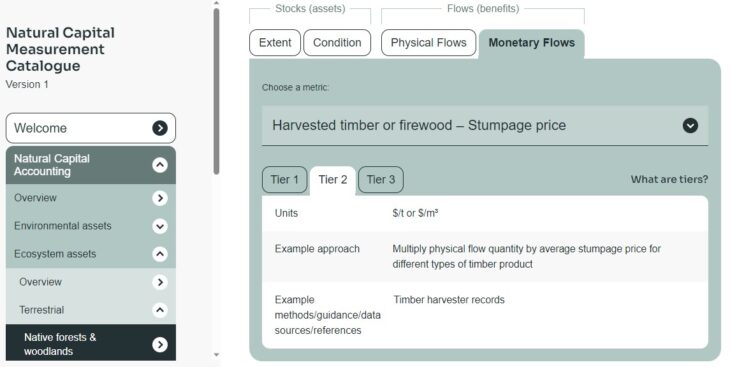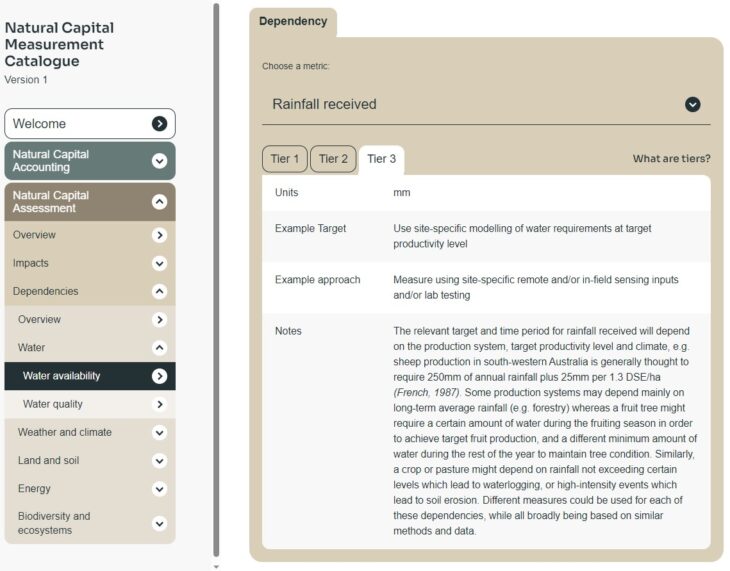Spotlight: Natural Capital Measurement in Australia
,
Spotlight: Natural Capital Measurement in Australia
Establishing a Nature Repair Market
The Australian government’s Department of Climate Change, Energy, the Environment and Water is supporting a number of initiatives to align financial flows with nature-positive investments, activities and outcomes, piloting case studies to build industry readiness for the Taskforce on Nature-related Financial Disclosures (TNFD) framework.
Australia’s Nature Repair Market Bill 2023, currently in consultation, is looking to establish a transparent framework for a new system to register and certify biodiversity conservation and restoration projects on land or sea. The methodology and rules are to be ready for open trading in the second half of 2024 and an Innovative Biodiversity Monitoring Grants Program is funding the development of innovative and cost-effective solutions to biodiversity monitoring approaches.
A New Measurement Reference Source for Land-Based Natural Capital
With the support of the Macdoch Foundation, Climateworks Centre in Australia has been working for four years with industry, government and other cross-sectoral stakeholders and experts to compile a consistent set of natural capital metrics and methodologies.
The Natural Capital Measurement Catalogue (NCMC) Version 1.0, is a comprehensive, open resource that presents metrics and methods for measuring flows of services and benefits from natural capital assets, and organisational impacts and dependencies on nature. The resource will support businesses, financial institutions and government to measure their natural capital, with the aim of providing consistency and integrity in reporting, informing efficiencies and managing risks.
|
The NCMC supports business and government to measure – and consequently manage – their natural capital assets, flows of services or benefits, and organisational impacts or dependencies on nature. |
When businesses incorporate natural capital into their decision-making, it creates space for improvements in a range of areas, such as supply-chain management, risk assessment and management, business sustainability, resilience, and uninterrupted production and operation.
Governments can use information on the state of natural capital to provide important practical information for evaluating different policies, investment objectives and financial risk management.
This live resource will continue to be refined, expanded and tested over time, from in-use, cross-sector feedback and support from a technical reference panel and advisory group.
The measurement system aligns closely with international frameworks, protocols and standards including:
- United Nations System of Economic-Environmental Accounting (SEEA)
- Taskforce on Nature-related Financial Disclosures (TNFD)
- IUCN Global Ecosystem Typology
- Natural Capital Protocol
The catalogue presents three ‘tiers’ of metrics and methods, descriptions of each section, as well as definitions and resources. Tiers correspond to different user needs and approaches to measurement. An organisation can select metrics and methods relevant to context and purpose to calculate extent, condition, physical and monetary flows, and produce natural capital accounts and/or natural capital assessments.

The natural capital assessment sections of the catalogue provide a framework for consistent measurement aligned to the TNFD, benchmarking against best practice to calculate impacts e.g. water footprint of timber, or dependencies such as water availability for forestry.

The NCMC uses the International Union for Conservation of Nature (IUCN) global ecosystem typology with adaptive units to check equivalencies, estimate land volume and map carbon for example. An example application for Scottish land might be to assess impacts on peatland through the Wetlands tiers. Measuring the extent of retained carbon with third party GIS remote sensing, in combination with ground-truthing for detailed site mapping.

Scenario Modelling
Climateworks’ Land Use Futures program is upgrading a research and analysis tool, Land Use Trade-offs model (LUTO), that can make detailed projections representing how Australia’s landscape could change in the future, depending on specific economic, social and environmental goals, conditions and policy settings.
LUTO is a spatial model, producing maps that represent the physical arrangement of land uses, comparing with a ‘business as usual’ scenario model of a future in which current trajectories continue. The model determines the potential arrangement of land uses in a way that can simplify complex interactions and show the potential costs and benefits of different actions, helping inform decisions that will support a more sustainable land use future for Australia.
World Bank Report
Modelling-based research has been used in the World Bank report – Nature’s Frontiers: Achieving Sustainability, Efficiency, and Prosperity with Natural Capital, which builds trajectories of sustainable resource efficiency to provide recommendations on how countries can better use their natural capital to achieve their economic and environmental targets, highlighting inefficiencies to provide cost-effective and economically attractive ways to achieve global sustainability goals. Key findings show:
|
Better allocation and management of land, water, and other inputs could lead to increases in agriculture, grazing, and forestry annual income by approximately US$329 billion—and enough food production increases to feed the world until 2050—without net loss of forests and natural habitats. |
Using cutting-edge, integrated natural science and economic models with an extensive new global dataset, the report includes an appendix of methodology and data sources used for components of the landscape efficiency score, including net revenues, greenhouse gas storage and emissions reductions and a combination of six biodiversity metrics.
Models and resources such as these, although in the early stages of use, begin to show us with more clarity where practical changes can be made to provide efficiency gains in land management, and see ahead to the longer-term impacts of the adaptations we urgently need at country level, and collectively at global level.
